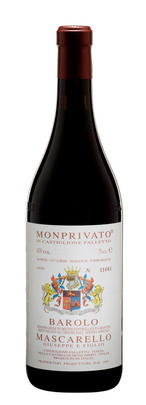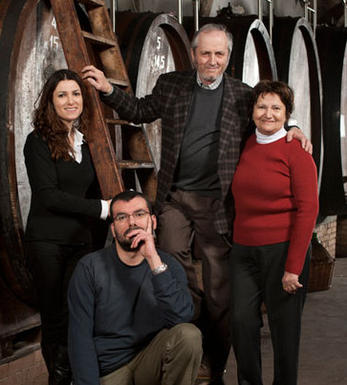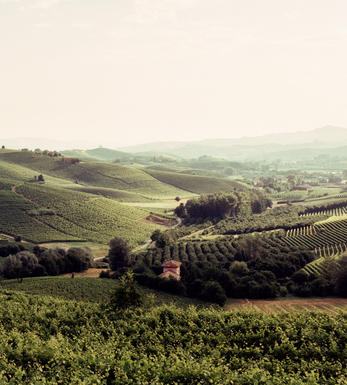
2008 Barolo, Monprivato Cà d'Morissio, Riserva, Mascarello Giuseppe & Figlio, Piedmont, Italy

Critics reviews
Monica Larner - 31/08/2017
About this WINE

Giuseppe Mascarello & Figli
Giuseppe Mascarello e Figlio surely ranks as one of Barolo’s finest producers. The family business dates back to 1881 & to Monforte d’Alba. Maurizio (Morissio) bought the Castiglione Falletto Monprivato vineyard in 1904, planting it with the Nebbiolo Michèt clone, before relocating the winery to Monchiero in 1919.
Son Giuseppe took over the business in 1923, abandoning the other family business of building materials to concentrate on wine. His son Mauro has been fine-tuning the estate since 1967, notably by lowering the yields, introducing a sorting table to ensure perfect bunches, and by releasing Monprivato as a single vineyard wine from 1970. Since 1996 he has been joined by his son Giuseppe, a wine technician. Mauro’s wife Maria Teresa looks after the books.
While the 12ha estate is dominated by vineyards in the commune of Castigilione Falletto, notably Monprivato at 6.20ha, in 1989 Mauro bought Santo Stefano, a single iron-rich vineyard in the Perno hamlet of Monforte d’Alba. All the wines are traditionally made using a combination of epoxy-lined cement & stainless-steel cuves, before being aged in large slavonian botte; capturing the vineyards' full expression

Barolo
Located due south of Alba and the River Tanaro, Barolo is Piedmont's most famous wine DOCG (Denominazione di Origine Controllata e Garantita), renowned for producing Italy's finest red wines from 100 percent Nebbiolo.
Its red wines were originally sweet, but in 1840 the then extant Italian monarchy, the House of Savoy, ordered them to be altered to a dry style. This project was realised by French oenologist Louis Oudart, whose experience with Pinot Noir had convinced him of Nebbiolo's potential. The Barolo appellation was formalised in 1966 at around 1,700 hectares – only a tenth of the size of Burgundy, but almost three times as big as neighbouring Barbaresco.
Upgraded to DOCG status in 1980, Barolo comprises two distinct soil types: the first is a Tortonian sandy marl that produces a more feminine style of wine and can be found in the villages of Barolo, La Morra, Cherasco, Verduno, Novello, Roddi and parts of Castiglione Falletto. The second is the older Helvetian sandstone clay that bestows the wines with a more muscular style. This can be found in Monforte d'Alba, Serralunga d'Alba, Diano d'Alba, Grinzane Cavour and the other parts of Castiglione Falletto. Made today from the Nebbiolo clones Lampia, Michet and Rosé, Barolo has an exceptional terroir with almost every village perched on its own hill. The climate is continental, with an extended summer and autumn enabling the fickle Nebbiolo to achieve perfect ripeness.
Inspired by the success of modernists such as Elio Altare, there has been pressure in recent years to reduce the ageing requirements for Barolo; this has mostly been driven by new producers to the region, often with no Piedmontese viticultural heritage and armed with their roto-fermenters and barriques, intent on making a fruitier, more modern style of wine.
This modern style arguably appeals more to the important American market and its scribes, but the traditionalists continue to argue in favour of making Barolo in the classic way. They make the wine in a mix of epoxy-lined cement or stainless-steel cuves, followed by extended ageing in 25-hectoliter Slavonian botte (barrels) to gently soften and integrate the tannins. However, even amongst the traditionalists there has been a move, since the mid-1990s, towards using physiologically (rather than polyphenolically) riper fruit, aided by global warming. Both modernist and traditional schools can produce exceptional or disappointing wines.
Recommended traditionalist producers:
Giacomo Borgogno, Giacomo Conterno, Bruno Giacosa, Elio Grasso, Marcarini, Bartolo Mascarello and Giuseppe Mascarello.
Recommended nmdernist producers:
Azelia, Aldo Conterno, Luciano Sandrone, Paolo Scavino and Roberto Voerzio

Nebbiolo
Nebbiolo is the grape behind the Barolo and Barbaresco wines and is hardly ever seen outside the confines of Piedmont. It takes its name from "nebbia" which is Italian for fog, a frequent phenomenon in the region.
A notoriously pernickety grape, it requires sheltered south-facing sites and performs best on the well-drained calcareous marls to the north and south of Alba in the DOCG zones of Barbaresco and Barolo.
Langhe Nebbiolo is effectively the ‘second wine’ of Piedmont’s great Barolo & Barbarescos. This DOC is the only way Langhe producers can declassify their Barolo or Barbaresco fruit or wines to make an early-drinking style. Unlike Nebbiolo d’Alba, Langhe Nebbiolo can be cut with 15% other red indigenous varieties, such as Barbera or Dolcetto.
Nebbiolo flowers early and ripens late, so a long hang time, producing high levels of sugar, acidity and tannins; the challenge being to harvest the fruit with these three elements ripe and in balance. The best Barolos and Barbarescos are perfumed with aromas of tar, rose, mint, chocolate, liquorice and truffles. They age brilliantly and the very best need ten years to show at their best.


Buying options
Add to wishlist
Description
On tasting the wine at the cantina on 4th March 2015, Mauro's son Giuseppe was keen to stress that this 2008 Ca d'Morissio possessed 31 grams of dry extract, compared to 29 for the 2006, and that 2008 has been released a year earlier in time for EXPO 2015 in Milano! What's indisputable is that this is a very svelte Ca d'Morissio; as ever the product of hallowed, fist-sized Michet clone Nebbioli that hang at one end of the Monprivato vineyard, gazing directly into the sun.
The wine's elegance enhanced by a very gentle vertical press, making the wine taste almost like pure free-run juice. Aged for 5 years in traditional large slavonian botte, following a stainless-steel ferment, the 2008 vintage is immensely gratifying even so young. 2006 is perhaps more muscular; 2008 is balance personified; both products of their differing vintages.
Bright rose-hip red garnet/blush in colour, the nose is both emphatic as well as serene, totally at ease 'in its own skin'. It's a detailed and delicately insistent nose of rose and strawberry, along with Monprivato esque red cherry spirit, of camphor and quinine. To taste/drink, the weave is compelling, (31 grams of dry extract!) full of tight red berries, of groseilles, ribes rosso (cranberry), with great intricacy, cool crunch and a quinine/Chinato edge. The fruit tannins are so setoso (silky) as to be invisible. Such flowing finezza!
David Berry Green
wine at a glance
Delivery and quality guarantee